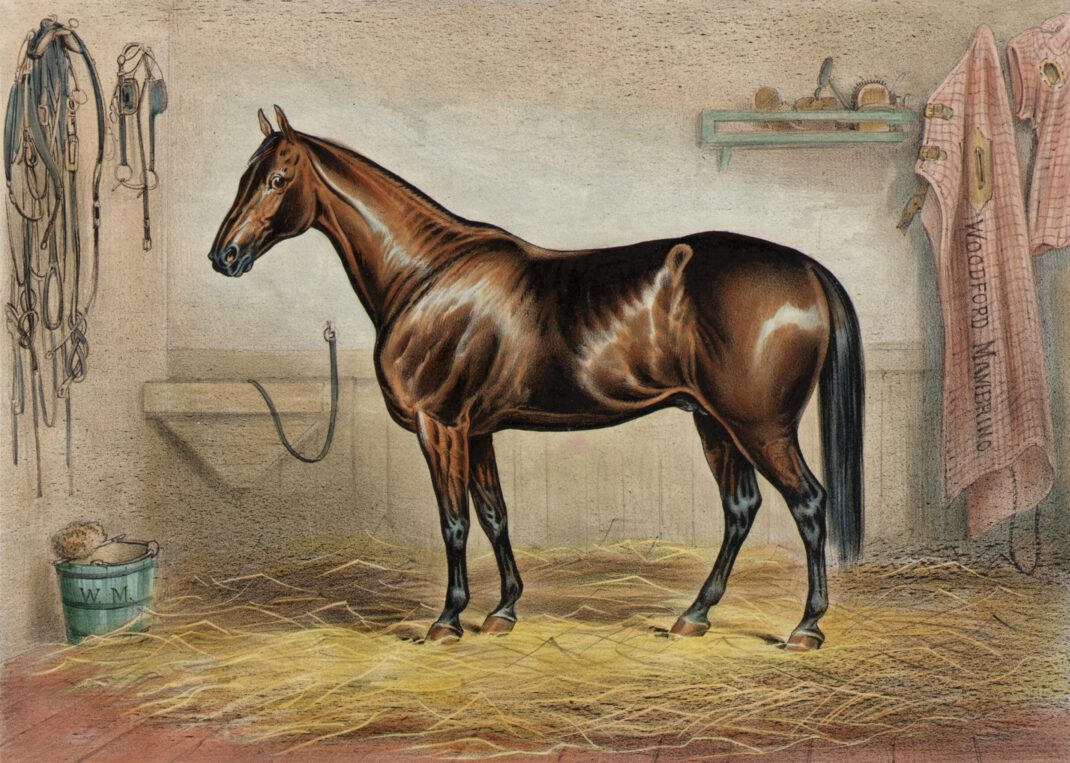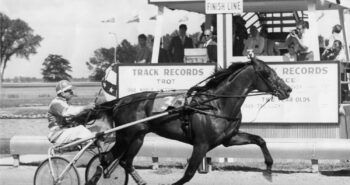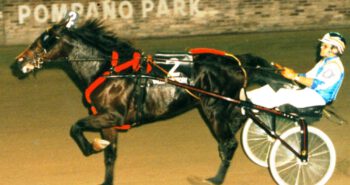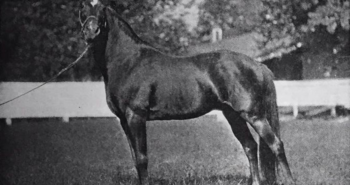He had a downright weird racing career, not competing regularly until he was 15. There he showed glimpses of brilliance despite an injury that just kept getting worse. Kept at stud for most of his life, but relatively unsupported by his famous owner, Woodford Mambrino was one of the more impressive stallions of the 19th century America.
Bred by Mason R Henry and foaled in 1863 during the Civil War, Woodford Mambrino was the last foal from Mambrino Chief. The colt was bought young by Robert A Alexander and brought to his legendary Kentucky nursery Woodburn. At 3, the horse was trained and started once, at Louisville on Nov 2, 1866. That resulted in a clear win in 2:40 (1.39,4) in a race with a stand-still start. Woodford Mambrino was the devoted to standing stud, but quickly gained a reputation for speed, despite not starting any other races for a long-time. According to journalist and horseman Hamilton Busbey, “Robert Bonner, the first time he visited Woodburn, greatly admired the stallion and he said to me that he would cheerfully give $20,000 for him. But Mr Alexander preferred to keep the horse in stud.”
The young stallion was noted for more than just speed, though, as he was a magnificently-looking colt. He was described as “a beautiful mahogany bay, standing 15,3 hands (160 cms) high, and was characterized by an unusually muscular development and powerful form for a horse of his weight – about 1,100 pounds. He was conspicuous for his fine neck, magnificent chest, and large, intelligent eye. Taken altogether, he was a superb animal, and in some respects had not his equal for beauty among his compeers.”
Though not racing, Woodford Mambrino was gently trained each year. According to The American Trotter, A Treatise on His Origin, History and Development by S.W. Parlin, in 1872, Woodford Mambrino “suffered from a fistula of the withers (…) was not worked for speed that season or the following one, but was put in training again in 1874.” At Lexington on Oct 1, 1874, Woodford Mambrino trotted a public trial in 2:20 1/4 (1.27,3), a time unprecedented by a stallion and reportedly with no preparation. Shortly after, Robert Bonner offered $35,000 for the stallion, but owner Alexander refused to sell the colt at any price. A month prior Goldsmith Maid had lowered her own world record to 2:14 (1.23,3), but 2:20 was still considered a near impossible mark: only one or two handful of horses were capable of such a clocking at the time. Despite being 11 years old, Woodburn Mambrino was still a few years away from racing consistently.
Fast forward three more years and Alexander J Alexander, who had taken over Woodburn Stud after his brother Robert A Alexander’s death on Dec 1, 1867, put the horse in regular training. According to Busbey this was because of the horse’s injury; “Later a shoulder bruise developed into a fistula, and then Woodford Mambrino was on the market.” In an article in the Washington Post on Mar 26, 1911, “fistula of the withers had set in and had slowly burrowed down deep into the muscles of his shoulder, and yet he responded cheerfully to every call made upon him. The disease, which was sapping his vitality, proved to be incurable.”
A short but spectacular career
On Aug 23, 1877, Woodford Mambrino started his racing career in earnest, easily defeating Fanny Stoner, Blanche Amory and Jim in straight heats in Cynthiana, KY, trotting in 2:34 1/2, 2:38 and 2:35 1/2 (1.36,0, 1.38,2 and 1.36,3). On the same day he also trotted an exhibition heat in 2:22 1/2 (1.28,6). Sold to LB Dubois of Colorado for $4,000, the next month he went to Atlanta and lowered his record to 2:31 1/4 (1.34,0). In October he was resold for $8,000 to St. Louisan Robert C Pate, also known as the “Gambling King.” The colt was then 14 years old. Always known for speed, Woodford Mambrino would now finally be allowed to show his abilities on the track.
In the care of trainer Charles Myers and trained at the Spanish Pond farm, Woodford Mambrino had a stellar season at 15. Making his seasonal debut at Milwaukee on Jun 5, 1878, Woodford Mambrino dominated the 2:26 class, winning in three straight heats in 2:25 1/2, 2:25 and 2:26 1/4 (1.30,4, 1.30,1 and 1.30,9). 6 days later he again won the 2:26 class at Jackson, losing the first heat to Dictator but then winning three straight. At the same time, his son Convoy won the 3:00 class. A week later it was more of the same as both Woodford Mambrino and Convoy repeated at Grand Rapids. Going to East Saginaw, both father and won was put outside the betting “as no one would put a cent against them.”
There would be no repeat, though, as Convoy surprisingly lost his race. Woodford Mambrino, however, continued to dominate. According to the Chicago Tribune, “the sport was tame in one race, and intensely exciting in the other. Woodford Mambrino won the 2:26 race in a manner that established him as a dangerous horse in any company, each heat being literally a jog for him (…) In the first heat Woodford Mambrino went easy the first quarter, but cutting loose down the backstretch it looked as if he would distance the field. Time at the half, 1:11. On the homestretch he was slowed up, and finally beat Kernan a neck in 2:27 1/4 (1.31,5). The second heat he was under restraint all the way and won in 2:28 1/4 (1.32,1). At the finish Rose of Washington was second by a length. Monarch Rule brushed to the front at the word for the third heat. At the half she had five lengths of a lead. Woodford was given his head in the next quarter and shot to the front in short order, coming into the home stretch with a clear lead, which he retained to the wire.”
Woodford Mambrino again defeated the 2:26 class in three straight heats in Detroit on Jul 4, 1878. The 15-year-old colt tasted his first defeat in Toledo on Jul 17 as Edwin Forrest won the 2:24 class in three straight heats, with Woodford Mambrino second in the first two heats and third in the final. The colt was clearly losing form, and went winless for several races until he won the stallion race at Minneapolis in early September, winning in three straight heats . “It was at Minneapolis that he covered himself with glory and established a name and fame that will ever adorn the annals of trotting. The great stallion race brought him in contact with Scott’s Thomas, Bonesetter and Indianapolis, unquestionably the fastest stallions besides himself on the turf. It was a desperate race. Each of the others tackled Woodford Mambrino in turn, striving to wear him out by contact brushing, but all in vain, for on an unfavorable day and comparatively slow track he captured first money in unbroken heats of in 2:21 1/2, 2:22 1/4 and 2:22 3/4 (1.27,9, 1.28,4 and 1.28,7). The next week, at Dubuque, he again won the stallion purse from the same field, in a race of seven heats. In this contest he was lamed and did not recover during the remainder of the season. He was drawn at Kansas City. At the fall trotting metting in this city he started against Bonesetter and Scott’s Thomas, but was so lame that he was barred in the pools. Nevertheless, the won second money.”
Busbey’s words, “the stallion was worn to a shadow and he did not recover from the strain” appears to be ringing true. 1878 was the colt’s swansong. On March 31, 1879, according to the St Louis Globe-Democrat, Woodford Mambrino died “of congestion of the lungs. This is undoubtedly the greatest misfortune that has befallen the trotting turf for many years, for Woodford Mambrino combined rare speed and breeding, and was the sire of several noted and many promising trotters.” The death was so sudden the owner Pate only learned about it when visiting his farm the following day.
Big impact despite few foals
The stallion career of Woodford Mambrino was in some ways puzzling. AJ Alexander had kept the speedy colt at stud, but, as written in the Chicago Tribune on Apr 5, 1879, “in spite of his speed and breeding Woodford Mambrino was not in high favor with Mr Alexander, being a peculiarly unfortunate horse.” Despite so many years at stud, Woodford Mambrino only had 86 foals at the time of his death. Busbey argued that “if the life of Woodford Mambrino had not been cut short, the rugged stallion would have obtained high ranks as a producer of race horses. His blood is breeding on.” Taking stock in 1911, an article in the Washington Herald states that “the Year Book credits Woodford Mambrino with twenty-five sons that have sired 145 trotters and 25 pacers, and with 26 daughters that have produced 44 standard records, 43 of which are trotters.” His son Pancoast was sold at auction in 1886, aged 9, for then-record price $28,000. Pancoast sired full-brothers Patron, Patronage and Prodigal, the latter found in all present pedigrees as he is found on the maternal side of Evensong, among others. Patronage also exceled at stud, and sired Alix, whose 2:03 3/4 (1.16,9) in 1894 was the absolute world record. Sweet Little Alix was the only one from Mambrino Chief’s sireline to hold the absolute world record. Another son of Woodford Mambrino, Princeps, sired Trinket, the mare who was one of the best trotters in the US between 1879 and 1883.
Yet another son of Woodford Mambrino was Berlin, born 1870. He first exported to Scotland before he was sold to New Zealander Robert Wilkin in 1880 and imported to that country the following year. According to an article on the New Zealand Hall of Fame website, Berlin “became a major influence on our breeding development as can be seen as his stud career unfolds. His 60 winners came at a time when trotting was in it’s infancy and his achievements pro rata would equal most leading sires who followed him. He produced two horses who could fairly be called champions and one other who came very close to that rating, and his daughters bred on well. There are not many top families who do not carry Berlin blood somewhere along the line.”
After his death, Woodford Mambrino was recognized as the best son of Mambrino Chief. In a time where most of the focus was on Hambletonian and his sons, Woodford Mambrino clearly was one of the best stallions around – but never got the chance to fully show it.
WOODFORD MAMBRINO
Bay colt born in Woodford County, KY in 1863. Died in St Louis, MO on Mar 31, 1878.
Mambrino Chief – Woodbine (Woodford)
2.21 1/2 (1.27,9)
Breeder: Mason R Henry
Owners: Mason R Henry – Woodburn Farm (RA Alexander, then AJ Alexander) – LB Dubois – Robert C Pate
Trainers: Charley Myers and others
Drivers: Charley Myers and others
Groom: –





